How Do Belgian Malinois Fare as Family Pets Compared to German Shepherds?
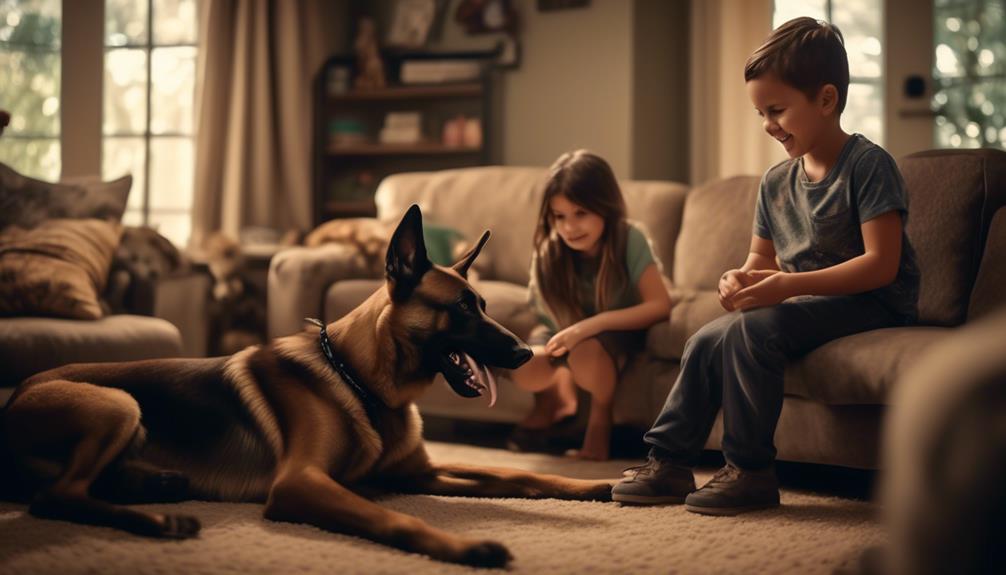
Belgian Malinois and German Shepherds are two popular breeds often considered as family pets.
When comparing size, both breeds are similar, with males typically weighing between 60-80 pounds and females between 40-60 pounds.
In terms of temperament, German Shepherds are known for their loyalty, protectiveness, and gentleness, while Belgian Malinois are more intense, focused, and driven.
As for energy levels, both breeds are highly active and require plenty of exercise. However, Belgian Malinois are generally more energetic and require more mental stimulation than German Shepherds.
In terms of trainability, both breeds are highly intelligent and trainable. German Shepherds tend to be more eager to please and easier to train, while Belgian Malinois may require more experienced handling and consistent training.
In terms of grooming needs, both breeds have a dense double coat that sheds year-round. Regular brushing is necessary to keep their coats healthy and reduce shedding.
When it comes to compatibility with children and other pets, both breeds can be excellent family pets when properly socialized and trained from an early age. However, German Shepherds are often more tolerant and patient with children and other pets compared to Belgian Malinois, who may be more reserved and cautious.
In conclusion, while both Belgian Malinois and German Shepherds can make great family pets, there are some differences in their temperament, energy levels, trainability, grooming needs, and compatibility with children and other pets that potential owners should consider before making a decision.
Key Takeaways
- Belgian Malinois are generally smaller and leaner than German Shepherds, making them easier to handle and lift.
- Belgian Malinois have high energy levels and require an active lifestyle with plenty of exercise to prevent boredom and destructive behaviors.
- German Shepherds have a slightly calmer temperament compared to Belgian Malinois.
- Proper socialization and training are important for both breeds to be excellent family pets.
Size Comparison
Belgian Malinois and German Shepherds differ in size, with the former generally weighing less and having a leaner body compared to the bulkier and heavier German Shepherds. When considering a family pet, size can be an important factor to take into account. Belgian Malinois, being smaller and lighter, may be more suitable for families who prefer a dog that's easier to handle and lift. On the other hand, German Shepherds, being larger and more robust, may be better suited for families who desire a dog with a strong presence and a sense of security.
The size difference between these two breeds also has implications for their physical traits. Belgian Malinois have a more streamlined and athletic build, while German Shepherds have a more substantial and muscular physique. This difference in size and body type may be indicative of their respective energy levels and activity requirements. Belgian Malinois are known for their high energy levels and need for regular exercise. They thrive in active households that can provide them with ample opportunities for physical and mental stimulation. German Shepherds, although still active, may have slightly lower energy levels and may be more adaptable to different lifestyles.
In terms of loyalty and protectiveness, both breeds are known for their exceptional qualities. Belgian Malinois and German Shepherds are intelligent and trainable, making them excellent choices for families seeking a loyal and protective companion. Their size difference may also affect their protective abilities, as German Shepherds' larger size may make them more physically intimidating to potential threats.
Temperament and Behavior Differences
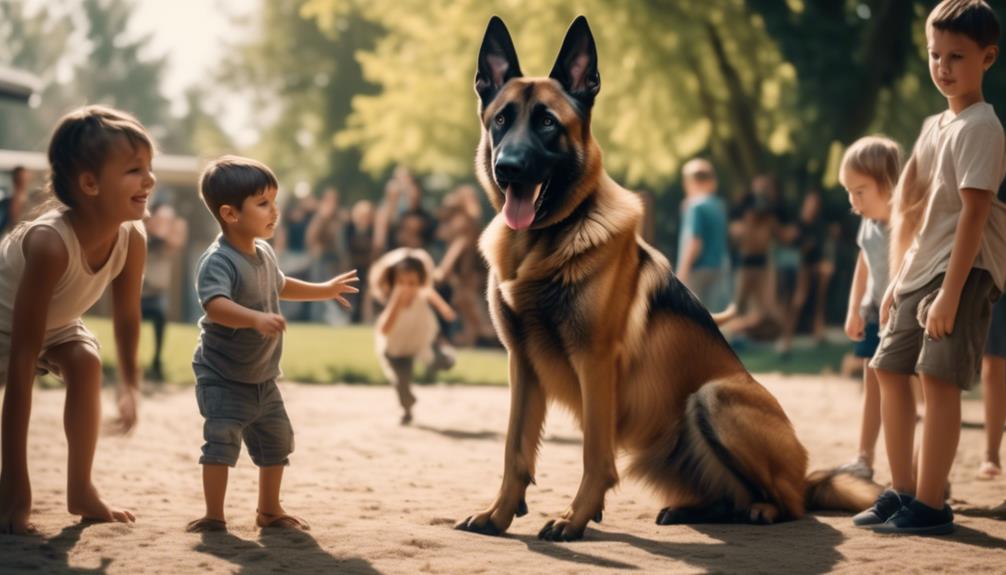
When comparing the temperament and behavior of Belgian Malinois and German Shepherds, it's important to consider their distinct characteristics and traits. Both breeds are known for their loyalty and protective instincts, making them great family pets. However, there are some notable differences in their temperaments and behaviors.
- Belgian Malinois:
- Highly intelligent and trainable dogs, making them suitable for various tasks such as search and rescue, police work, and service dog roles.
- Known for their high energy levels and need for mental and physical stimulation.
- Require an active lifestyle with plenty of exercise and mental challenges to prevent boredom and destructive behaviors.
- German Shepherds:
- Equally intelligent and trainable dogs, often used in similar working roles as Belgian Malinois.
- Tend to have a slightly calmer temperament compared to Belgian Malinois.
- Still require a moderate amount of exercise and mental stimulation to prevent behavioral issues.
Both breeds excel in obedience training and can be excellent family companions when properly socialized and trained. However, due to their high energy levels, Belgian Malinois may require more time and effort to meet their exercise needs. German Shepherds, on the other hand, may be slightly more adaptable to different lifestyles and may be better suited for families with a less active lifestyle.
Ultimately, the choice between the two breeds should be based on the family's lifestyle, preferences, and ability to meet the needs of these intelligent and active dogs.
Energy Levels and Exercise Needs
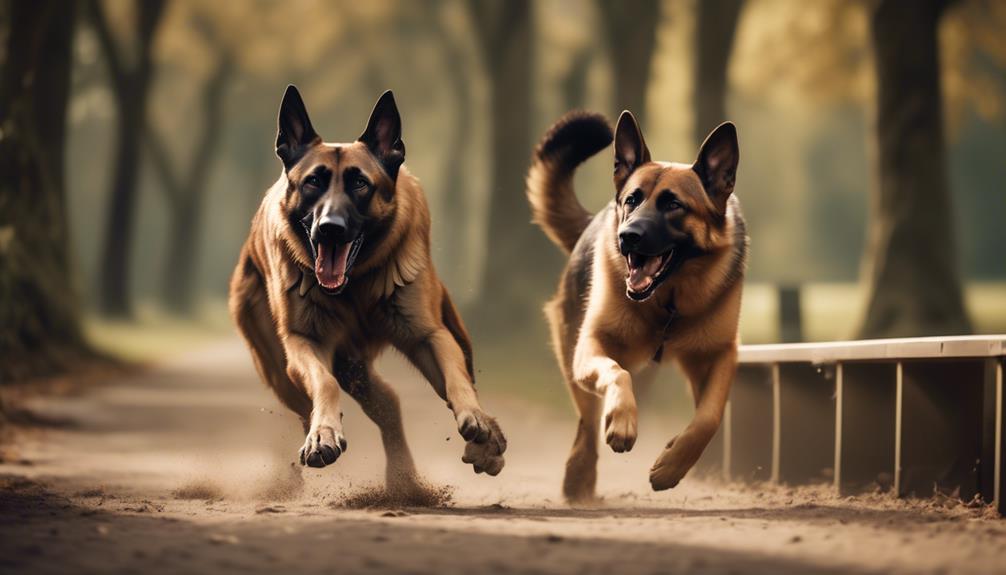
Both the Belgian Malinois and German Shepherds have high energy levels and require regular, intense physical activity to thrive. These dog breeds are known for their athleticism and endurance, making them excellent companions for active families. Belgian Malinois, in particular, have extremely high energy levels and need vigorous exercise daily to prevent boredom and destructive behavior. German Shepherds also have high energy levels and benefit from regular exercise to maintain their physical and mental well-being.
Both Belgian Malinois and German Shepherds thrive with mental stimulation and interactive play to channel their energy. Regular outdoor activities such as running, hiking, and playing fetch are essential for both breeds. These activities not only help them burn off excess energy but also provide an opportunity for them to engage their senses and stay mentally stimulated.
Failure to provide adequate exercise for these high-energy breeds can lead to health issues and behavioral problems. Without regular exercise, Belgian Malinois and German Shepherds may become anxious, restless, and prone to destructive behaviors such as excessive chewing or digging. They may also develop obesity and related health issues if their exercise needs aren't met.
It is important for families considering either a Belgian Malinois or a German Shepherd as a family pet to be committed to providing regular exercise and mental stimulation. A daily routine that includes physical activity and training sessions will help these energetic breeds thrive and be happy, well-behaved members of the family.
Trainability and Intelligence
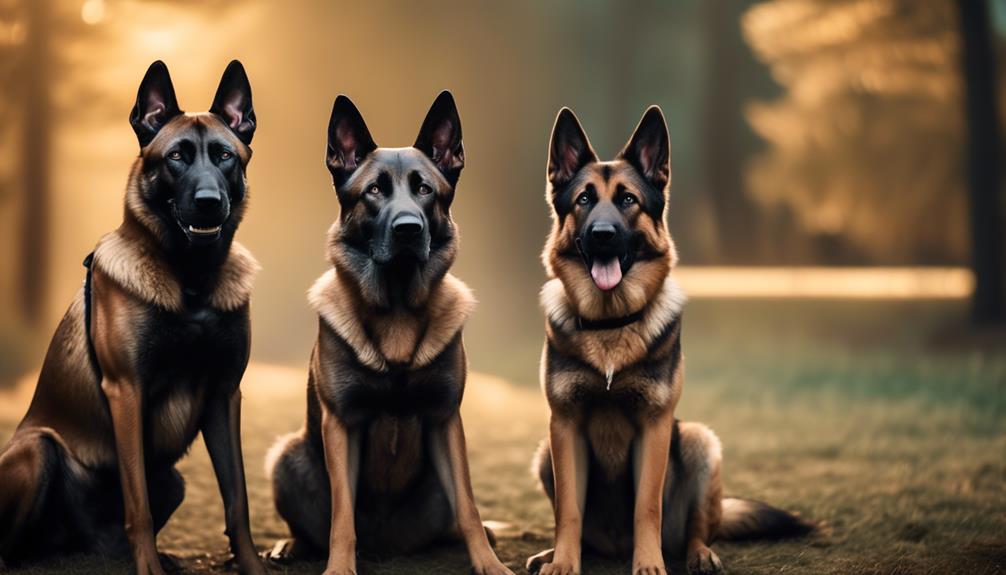
Highly intelligent and trainable, both the Belgian Malinois and German Shepherds excel in obedience and agility training. When comparing their trainability and intelligence as family pets, several factors come into play:
- Eagerness to please: Belgian Malinois are known for their eagerness to please and seek recognition for a job well done. They thrive on praise and positive reinforcement. On the other hand, German Shepherds are intelligent and obedient, with a natural instinct to protect their owners. They're motivated by their loyalty and desire to serve and protect their family.
- Learning preferences: German Shepherds can be more independent workers compared to Belgian Malinois. They may be more stubborn during training, but they prefer learning a variety of new tasks. On the other hand, Belgian Malinois thrive on routine and repetitive training. They excel when given clear instructions and a consistent training schedule.
- Socialization and temperament: Both breeds require early socialization to avoid aggression and wariness of strangers. Belgian Malinois are highly alert, responsive, and quick to respond to threats. They're known for their intense focus and drive. On the other hand, German Shepherds are loyal and protective of their family. They're known for their calm and confident demeanor, making them suitable for obedience, tracking, and search and rescue work.
Grooming and Maintenance Requirements
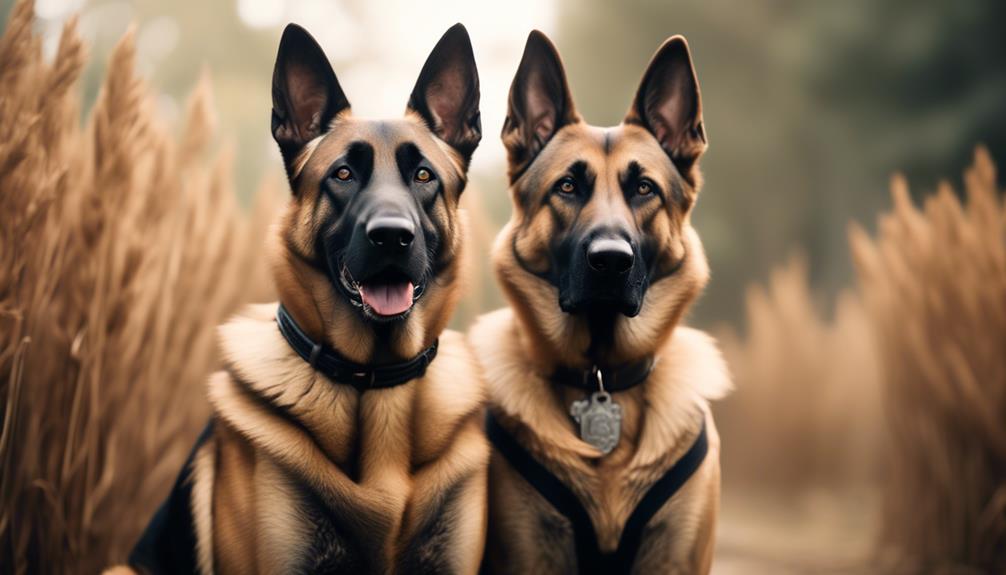
The next aspect to consider in comparing Belgian Malinois and German Shepherds as family pets is their grooming and maintenance requirements.
Both breeds have different coat types that require specific care. Belgian Malinois have a short, easy-to-maintain coat that usually only requires occasional brushing. However, during shedding seasons, which occur twice a year, they may need daily brushing to remove loose hairs.
On the other hand, German Shepherds have a thicker coat that requires regular brushing every few days to remove loose hairs and prevent matting. They also shed more profusely once or twice a year.
In terms of nail care, both breeds should have their nails trimmed regularly to avoid discomfort or potential injury.
Compatibility With Children and Other Pets
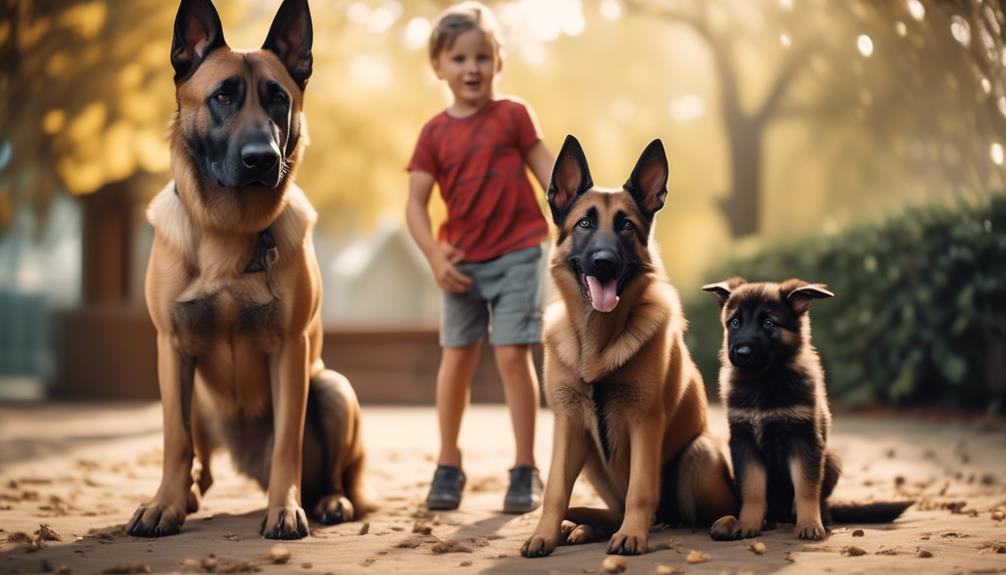
German Shepherds are generally considered to be more compatible with children, while Belgian Malinois may not be as suitable due to their reserved nature. However, both breeds can be great family pets with proper socialization and training.
Here are some key points to consider when it comes to the compatibility of these breeds with children and other pets:
- Early socialization is crucial for both German Shepherds and Belgian Malinois. It helps them develop positive relationships with children and other animals.
- German Shepherds tend to be more patient and observant with energetic children. They're known for their protective nature and are often gentle and tolerant.
- On the other hand, Belgian Malinois can be more sensitive and emotionally aware. This sensitivity can sometimes make them wary or startled by the unpredictable behavior of children, requiring careful supervision and gradual introductions.
- Both breeds are intelligent and loyal, making them excellent companions and protectors. However, Belgian Malinois may need more time apart from small children to decompress compared to German Shepherds.
- Consistent training and supervision are essential for both breeds to ensure they interact appropriately with children and other pets.
Overall Suitability as a Family Pet
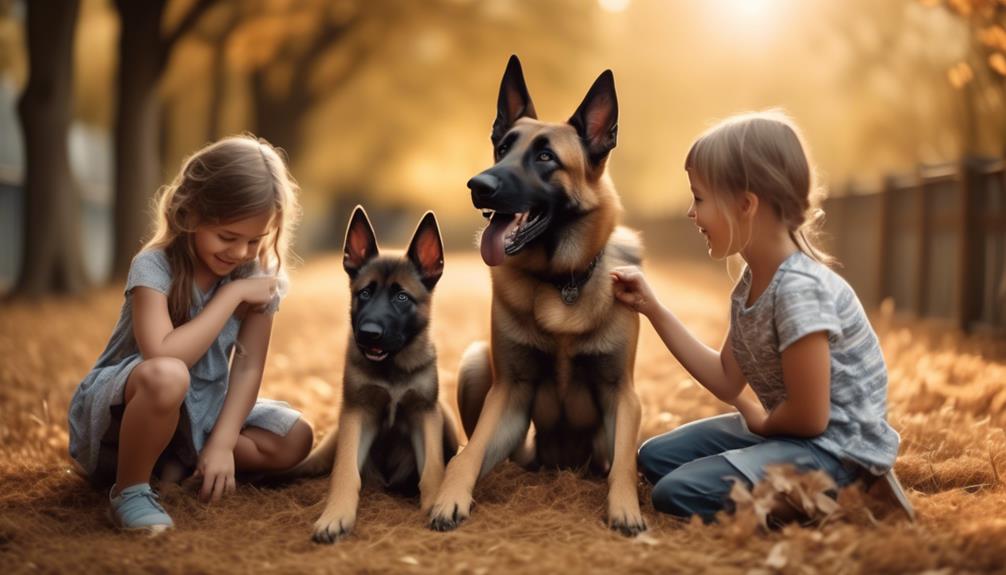
Belgian Malinois and German Shepherds can both be suitable family pets, with each breed having its own unique traits and considerations to keep in mind. When it comes to overall suitability as a family pet, there are several factors to consider.
| Traits | Belgian Malinois | German Shepherd |
|---|---|---|
| Loyalty | Very loyal and protective of their family | Extremely loyal and protective of their family |
| Intelligence | Highly intelligent and trainable | Highly intelligent and trainable |
| Activity Level | Extremely active and require plenty of exercise and mental stimulation | Active and require regular exercise and mental stimulation |
| Adaptability | May bond closely with one person and be reserved with strangers | Adaptable and affectionate with the whole family |
| Health | Generally considered healthier compared to German Shepherds | May be prone to certain health issues |
Belgian Malinois are known for their loyalty and protective nature, making them excellent family guardians. However, their high energy levels and need for mental stimulation may make them better suited for experienced and active owners. On the other hand, German Shepherds are generally more affectionate and patient with children, making them a better choice for families with kids. They are also adaptable and affectionate with the whole family. While both breeds require early socialization and training, German Shepherds are known for their well-rounded and stable temperament. Overall, both Belgian Malinois and German Shepherds can make wonderful family pets, but it is important to consider their specific traits and needs to ensure a good match for your family.
Frequently Asked Questions
Is a German Shepherd or Belgian Malinois a Better Family Dog?
A German Shepherd and a Belgian Malinois both have different strengths as family pets. The German Shepherd is known for its affectionate nature and compatibility with children, while the Belgian Malinois is more reserved and tends to bond closely with one person.
What Is the Disadvantage of Belgian Malinois?
The Belgian Malinois has a few disadvantages as a family pet. These include behavioral challenges, high energy levels, potential aggression issues, intense exercise requirements, and a need for mental stimulation. They may not be suitable for first-time dog owners or households with small children.
Do Belgian Malinois Make Good Family Dogs?
Belgian Malinois can make good family dogs, but they have specific needs. They require extensive training, regular exercise, and socialization with children and other pets. Grooming is relatively easy, and they have a lifespan of 10-14 years. However, they may not be suitable for all families due to their high energy levels and potential for territorial behavior. The cost of owning a Belgian Malinois includes expenses for food, veterinary care, and training.
Why Are Belgian Malinois Replacing German Shepherds?
Belgian Malinois are replacing German Shepherds due to their high energy levels, agility, and suitability as working dogs. They require consistent training, have different temperaments, and exhibit strong protective instincts. Size, grooming needs, and health concerns should also be considered. Socialization and activity levels are important, and they can be compatible with children.









